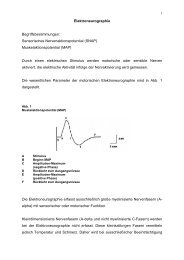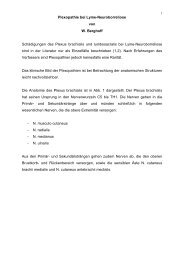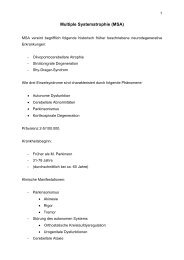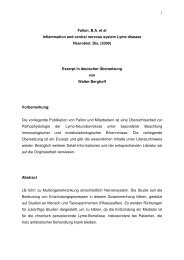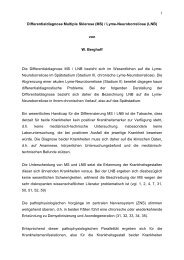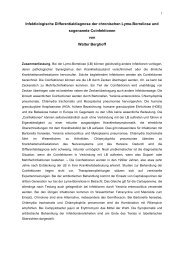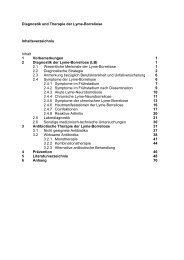Infectiologic differential diagnosis of chronic Lyme disease and so ...
Infectiologic differential diagnosis of chronic Lyme disease and so ...
Infectiologic differential diagnosis of chronic Lyme disease and so ...
Create successful ePaper yourself
Turn your PDF publications into a flip-book with our unique Google optimized e-Paper software.
2<br />
In cases <strong>of</strong> <strong>Lyme</strong> <strong>disease</strong> (LD), other infections, whose pathological synergism<br />
exacerbate the <strong>disease</strong> state or induce the same <strong>disease</strong> manifestations, can exist<br />
concurrently. Such concomitant infections are termed coinfections. The coinfections<br />
can al<strong>so</strong> be transmitted by ticks as LD is, i.e. a tick bite can result in multiple<br />
infections. A fraction <strong>of</strong> the coinfections is transmitted independently <strong>of</strong> ticks, or in<br />
addition to tick transmission there are other modes <strong>of</strong> transmission.<br />
The coinfections that are transmitted by ticks are given in Table 1; the coinfections<br />
that are independent <strong>of</strong> ticks are compiled in Table 2.<br />
In Europe ticks are not only infected by Borrelia burgdorferi but al<strong>so</strong> by other<br />
pathogens i.e. Human Granulocytic Anaplasmosis, Rickettsia, Coxiella burnetii,<br />
Babesia microti <strong>and</strong> Babesia divergens [351-354].<br />
The coinfections favor the expression <strong>of</strong> <strong>disease</strong> states by means <strong>of</strong> immune system<br />
modulation <strong>and</strong> are considered to be a major rea<strong>so</strong>n for therapy resistances [176 -<br />
192].<br />
The importance <strong>of</strong> the coinfections for the pathological process—i.e. their<br />
pathogenicity compared to <strong>Lyme</strong> <strong>disease</strong>—has not been clarified. Thus, in cases <strong>of</strong><br />
double or multiple infections, a decision cannot be made as to which infection<br />
dominates in the pathological process.<br />
In the symptomatology there are substantial overlaps between <strong>Lyme</strong> <strong>disease</strong> <strong>and</strong> the<br />
coinfections <strong>so</strong> that an unequivocal assignment <strong>of</strong> the <strong>disease</strong> manifestations to the<br />
existing infections is impossible. Many symptoms can thus be due to both a <strong>Lyme</strong><br />
<strong>disease</strong> <strong>and</strong> the <strong>so</strong>-called coinfections.<br />
The problematic nature <strong>of</strong> <strong>Lyme</strong> <strong>disease</strong> <strong>and</strong> coinfections always concerns the<br />
<strong>chronic</strong> course. The coinfections are thus only <strong>of</strong> importance for <strong>chronic</strong> <strong>Lyme</strong><br />
<strong>disease</strong> (late stage, stage III). On the other h<strong>and</strong>, the synergic-pathological<br />
mechanism requires that the coinfections al<strong>so</strong> are present in a <strong>chronic</strong> persistent<br />
form.





